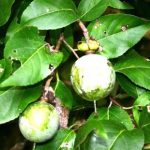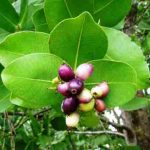TREE LIFE
OCTOBER 2006
MASHONALAND CALENDAR
Tuesday 3rd October Tom will still be away at this date and therefore the walk is cancelled.
Sunday 15th October: Lowdale Farm, Brian Townsend. Meet there at 9.30 a.m.
Saturday 28th October: Return visit to Mick Fleet’s home in Haslemere Lane, Umwindsidale area. We will meet at 2.30 p.m.
MATABELELAND CALENDAR
Please contact Jean Wiley or Gill Short for details of the next Matabeleland function.
HEROES’ WEEKEND: NYANGA: 12-15 AUGUST 2006
Saturday 12th August: All of the group (8 of us) traveled up to Nyanga the day before, on the Friday. Our visit took place during the time of the change of currency (the removal of the 3 zeroes) and we all enjoyed frequent roadblocks in which our cars were searched (often rather cursorily) for old bank notes.
The longest wait was in Marondera (about three quarters of an hour) and perhaps the most frustrating moment was in Rusape where, having been held up entering the town on the Harare road, we were then stopped again almost immediately on the Nyanga Rd. This was the slowest trip to Nyanga I have ever made. However, it all proceeded smoothly and by the evening we were installed in Tim Copley’s comfortable cottage at the John Galt Village.
Another sign of the times was the nearly invariable power cuts in the morning and evening. However, none of these events detracted from our enjoyment of the trip.
The John Galt village development is set in a bowl of hills and consists of mainly Brachystegia woodland, dissected by streams. It is not very far from the Pine Tree Inn and is definitely on the dry side of Nyanga. The actual development has been done very tastefully; the grey houses blend in very discreetly with the woodland vegetation and looking over the area from a high point it is actually not easy to see the houses at all.
Partly in order to stock up with some food, we decided to travel on the first day to Nyanga and from there to Troutbeck and World’s View. Even on that journey the police had a roadblock at the Troutbeck turn off, which we went through twice, but on neither occasion were we stopped. Nyanga village was basically ‘shut’ on this Saturday morning and we were largely unsuccessful in our attempts at shopping. We therefore went on to Troutbeck to try the store there; we also weren’t successful there at that time, but did manage to buy some things later.
On next on the dirt road to World’s View. This is an interesting drive as it gives easy access to a quite high altitude area (2240 metres) with interesting Helichrysum splendidum scrub, rocky areas and vleis. We reached the National Trust property, paid a very modest entry fee and visited the toposcope to admire the view over the drier side of Nyanga.
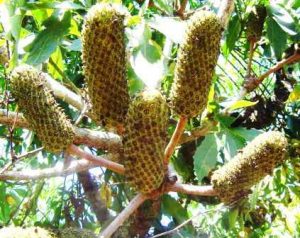
Cussonia spicata. Photo: Bart Wursten. Source: Flora of Zimbabwe
From there we walked some way up the rocky slope of the nearby hill. Here was a very typical collection of Eastern Highlands trees. Cussonia spicata (Cabbage tree) with its long stems and leaves with leaflets fitting together like bones in a vertebra. This has also rather cylindrical flower spikes arranged in compound umbels. It’s a very common species of open grassland and forest edges in the Eastern Highlands and of course extends a good way out of that area into savanna regions as well.
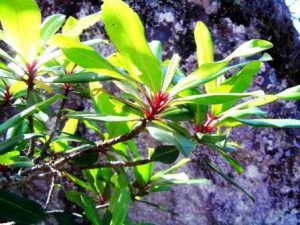
Rapanea melanophloeos. Photo: Bart Wursten. Source: Flora of Zimbabwe
Rapanea melanophloeos is the Cape beech. This has dark green leaves, often with reddish petioles and is fairly frequent at high altitudes in the east. A nice spot character for it is the translucent streaks in the leaf lamina; these are easily visible when a leaf is held up to the light and viewed through a lens.
A more scrubby, but quite pretty, species is Buddleja salviifolia. This has light mauve tubular flowers with an orange mouth; the flowers are numerous in each inflorescence. The leaves are characteristically grey and resemble the genus Salvia – hence the Latin name.
A little way up the hill, trees faded out and it became a very interesting collection of mainly herbaceous or small woody plants. Here we saw the sometimes puzzling Nuxia congesta and the ericoid species Phymaspermum bolusii, which looks like something out of the Cape flora.
There was also a windswept totally lop-sided pine, perched on the angle of the ridge, its branches flowing away from the prevailing wind.
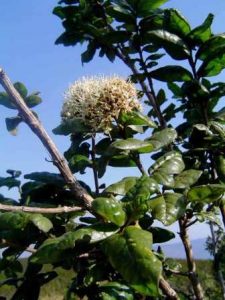
Nuxia congesta. Photo: Bart Wursten. Source: Flora of Zimbabwe
Here the prevailing wattle was Acacia mearnsii, but on the drive from Troutbeck to the Nyanga Rd, the wattle was mainly the Silver wattle, Acacia dealbata.
We ate our lunch in the National Trust car park and from there we drove to the church of St Catherine in the Downs. Many of the same species were re-recorded here. A very common species we saw so much of was Hypericum revolutum; a yellow-flowered St John’s Wort with narrow leaves. It seems to occur only at high altitudes and is mainly seen in the Nyanga area where it is very common. Also here, climbing on some shrubs was an escaped pink-flowered Bananadilla.
After that we drove home, stopping for provisions at the Superette in Montclair (and recording the small weed, Capsella bursa-pastoris just outside it).
All in all, it was a very good first day.
-Mark Hyde
Sunday 13th August:
Shortly after breakfast on Day Two we all went with Mark to Rhapsody Cottage near Punch Rock. Here, by prior arrangement, we were joined by Sylvia Welstead and drove a short distance to where Sylvia had a vineyard on the northwesterly slopes below Chinaka Mountain.
We then walked along the firebreak above the vineyards. Sylvia told us that the altitude here was 1870 metres above sea level. To begin with the vegetation seen comprised mainly bracken and grasses interspersed with Leonotis mollissima, Helichrysum species and Halleria lucida (Tree fuchsia). As we proceeded along the firebreak other small flowering plants were seen including Jamesbrittenia cavalhoi and Athrixia rosmarinifolia (Manica Daisy). Above the firebreak there was a belt of forest trees extending upwards to rock outcrops.
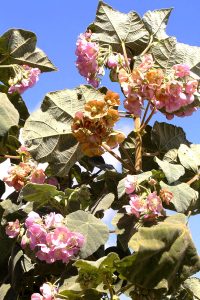
Dombeya burgessiae. Photo: Bart Wursten. Source: Flora of Zimbabwe
A foray into the forest revealed a variety of Eastern Districts trees and shrubs including Dombeya burgessiae, Cussonia spicata (in bud), Faurea speciosa, Heteromorpha aborescens (Parsnip Tree) and Thunbergia alata, a climber with black-centered yellow flowers sometimes called Black-eyed susan.
Growing close to a rock face in a shady area was a fig with a distinctive leaf which was almost heart-shaped or triangular truncate as described by Keith Coates Palgrave. This was Ficus craterostoma a somewhat rare fig of the Eastern Districts.
Also seen in the forest was Clausena anisata the leaves of which had a peppery smell when crushed, Gymnosporia (Maytenus) mossambicensis, a species of Maytenus with particularly ferocious spines, Vangueria apiculata, Buddleja salviifolia in flower, Rapanea melanophloeos or Cape beech, Catha edulis, Euclea divinorum with diamond-shaped leaves and very wavy leaf margins and many other trees the names of which I was too slow to pick up from Mark.
By a Waterberry we crossed over a small stream to a dwala at the base of which there was an area of spongy soil. Growing in the sponge was a member of the Crassula family namely a species of Kalanchoe. It had very striking bright yellow flowers.
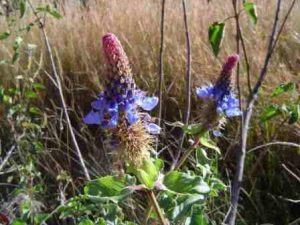
Pycnostachys urticifolia. Photo: Bart Wursten. Source: Flora of Zimbabwe
Close by was Pycnostachys urticifolia (Hedgehog Bush) but it was not in flower and only the dry “hedgehog ” remained on the old flower stalk.
As we were now beginning to feel peckish we retraced our steps along the fire break and Mark drove back to Rhapsody Cottage. Here we sat in the shade of a Musasa and ate our lunch whilst admiring the beautiful view under a bright blue sky warmed by the sun and with the perfumed scent of a flowering Musasa (Brachystegia spiciformis) wafting over us.
It was tempting to doze under these idyllic conditions but Tim our energetic host and guide roused us in order that we could proceed to our next venue namely Hidden Valley at Fox Rock. On arrival at Hidden Valley we met Mandy Callasse and Doug who kindly bid us welcome and made us free to roam around their garden and the camp site.
Hidden Valley undoubtedly deserves its name. As shown on Map Sheet SE-36-10 Fox Rock Township, as it is called, is on a local tableland at an altitude of between 1800 and 2100 metres. The area along the access road appeared to be fairly level with scattered rocks and trees but somewhat featureless. But on coming to Hidden Valley cottage we came upon a fantastic sight : a sharp falling away of the ground to a long narrow valley extending northward into the distance, the floor of the valley being covered in dense woodland. What hidden floral secrets did this valley hold I wondered ? It appeared to be totally uninhabited. We did not have the time then or the energy to descend into the valley to explore and contented ourselves with a walk through the garden and camp site.
In the garden there was a neat vegetable patch and an orchard with nice-looking lemons. The camp is neatly laid out amidst rocky boulders and has water and electricity laid on to individual units. There are male and female ablution blocks with showers, wash hand basins, a bath and toilets and a laundry with sinks. Hot water is supplied from a “Rhodesian boiler” . The camp is most attractive but it was sad to see it empty on this holiday weekend. At the viewpoint was Garcinia buchananii (Granite Garcinia), Rothmannia fischeri, Hymenodictyon floribundum and Cussonia natalensis, the simple leaved Cussonia.
An eye-catching plant in the camping ground was Senecio barbertonicus a succulent with cream-coloured buds, a somewhat rare plant Mark said. Among other trees and shrubs in the camp were : Aeschynomene nodulosa. In Zimbabwe this small tree or shrub is particularly common in the Eastern Districts .We saw the fruit with the typical semi-circular sections joined together on one side something like a row of false teeth.
We also saw Ficus natalensis, a fig of rocky areas and Dodonaea viscosa the sand olive with papery winged fruit, not to be confused with the fruit of Combretum species.
Returning to John Galt Village in the late afternoon we were in time to have tea before the daily power cut occurred. The ladies proceeded to prepare supper and eventually cook it when the power came on later in the evening. Our party of eight had many different countries of birth which were : England – Kathie; Zimbabwe – Tim; Yugoslavia – Vera and Dragana; China – Ang and Ping, South Africa – George and Canada – Mark. The result was that there was a bit of an international flavour at mealtimes both in conversation and in the cooking.
For instance with regard to the latter, Kathie provided a babotie (a South African dish) and a plum pie (English) whilst Vera cooked Serbian dishes ably assisted in various ways by Dragana, Ang and Ping.
All meals were most enjoyable and engendered an air of conviviality especially when aided by a little wine. Apart from eating, the evenings were spent in playing cards, reading or recording the trees of the day on computers, all in accordance with individual preferences.
George MacRobert To be continued …
VUMBA SPECIAL
This is the fourth article in an occasional, more lighthearted series about trees in the Vumba, written by our member Bart Wursten.
What’s in a name
Most of us mere “Tree Soc” mortals have trouble enough remembering the names of trees we see every day. We respect and honour the Marks, Megs and Toms, who do the remembering for us and tirelessly remind us again and again of the names and labels of trees and plants around us. Yet we can’t help feeling the occasional pinch of envy of those who are able to put names to every tree, plant and flower, as if only they can read the obvious tags and large banners, written across their stems and branches, invisible to the rest of us. The so-called rule-of-law laid down by scientific nomenclature is of no help in these DNA ridden times. As soon as we have finally mastered one of their near unpronounceable labels, the Abominable (t)Axonomists will lump, split or change it. It seems such a blessing to have plain-and-simple English names for everything instead.
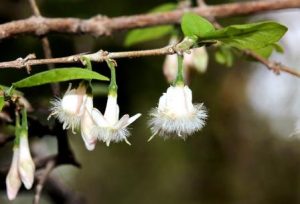
Tricalysia allenii. Photo: Bart Wursten. Source: Flora of Zimbabwe
There’s a modest shrub, usually minding its own business in riverine fringes or deciduous woodland. Only rarely it reaches the size and shape of a small tree. Just before the start of the rains, often still leafless and naked, it bursts into a mass of pretty white, bell-shaped flowers. Each flower, with a dense crown of long white hairs, resembles a small powder puff. It belongs to the family of Rubiaceae and for once it actually sticks to the rules by which we are supposed to recognize its family ties. It has simple, opposite and entire leaves (when it has any). It shows clear scar-like lines on the branches between the positions of the leaves, which we are told to call interpetiolar stipular scars. The symmetrical flowers have five petals, joined at the base into a tube (For those into the techno-botanical tongue-twisters, the actinomorphic flowers possess a gamopetalous corolla). It’s name used to be Tricalysia allenii but, unfortunately, we are now told to call it Tricalysia junodii var. kirkii. It remains questionable, however, whether a “plain-and-simple” English name like Northern Fluffy-flowered Jackal-coffee is really helping us out in this case.
Have a look at Tricalysia and its relatives on www.zimbabweflora.co.zw and, though Northern Fluffy-flowered Jackal-coffee is definitely not a Vumba Special, many of its Rubiaceae cousins can be enjoyed on a walk through the forests around Ndundu Lodge.
RESEARCHERS SCALE WORLD’S TALLEST TREE 378-foot coast redwood. By Lester Haines
Published Friday 8th September 2006.
Researchers in California have found what they reckon is the world’s tallest tree – a Coast redwood (Sequoia sempervirens) standing at a mighty 378.1 feet (115.2 metres), Reuters reports.
The giant, dubbed “Hyperion”, is one of a trio of monsters discovered in dense forest in the Redwood National Park near Eureka. The researchers say all three are taller than the previous record holder, Stratosphere Giant.
Hyperion’s height is subject to confirmation, which may involve scaling the beast with a tape measure. However, Rick Nolan, acting superintendent of Redwood National and State Parks, said: “There is a reasonable expectation that these trees will be larger than the ones known to be growing in the coastal redwood ecosystem. They would be the tallest living trees.”
MARK HYDE CHAIRMAN


